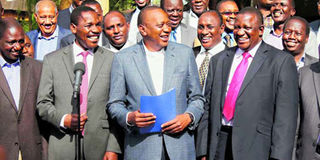How we can tackle challenges of devolution

President Uhuru Kenyatta and governors during the National and County Government Coordinating Summit at Sagana State Lodge in Nyeri on February 11, 2016. PHOTO | JOSEPH KANYI | NATION MEDIA GROUP
What you need to know:
- The chaotic relations between the national and county government has characterised media reports on devolution since the March 2013 elections.
- The 2010 Constitution provided for, among others, enhanced checks and balances within government, an enhanced role of Parliament and citizens, an independent judiciary, and a most progressive Bill of Rights.
- The frosty relations between the central and county governments must be thawed. None can work on its own without the other.
- Platforms like the recent governors’ summit in Sagana will help county governments deal with their relational problems with national government so that the county leadership can focus on ensuring devolution delivers what it promised to Kenyans.
The chaotic relations between the national and county government, alleged wastage of resources by MCAs and governors, bloated expenditure, power wars between senators and governors, impeachment of governors, the conflict between governors and their deputies are some of the many challenges that have characterised media reports on devolution since the March 2013 elections.
One would be forgiven to think that devolution is not working.
However, a look at history will show how far Kenya has come, and why devolution is one of the best things to happen in Kenya, yet.
During the first Lancaster House conference, the ban on African political parties was lifted and it heralded a new dispensation for the yet-to-be birthed republic called Kenya.
The first African political party in Kenya called Kanu was registered but then, soon after, minority communities felt that the party was an exclusive club of the “bigger” tribes.
Led by Ronald Ngala and Masinde Muliro, the second African party called Kadu was registered.
The main ideological difference between the two was simply the mode of governance. While the former preferred a central government system, the latter preferred a more federal system of governance locally known as majimbo.
Majimbo, ugatuzi, or devolution simply refers to the legal yielding of powers from the government of a sovereign state to government at a county level.
This means that any one level of government is not under any obligation to refer to or seek authority from the centre in order to make or implement decisions that fall within their exclusive jurisdiction.
However, as noted by Tom Mboya, the devolved units must not act as independent governments but rather as part of a larger state. The ultimate objective of devolution is to ensure that decision making is made easy and the national cake is shared equitably.
YEARNED FOR NEW CONSTITUTION
However, after independence, the centralised governance system triumphed. When Daniel Moi took power and governed Kenya for 24 years, a feeling of marginalisation was entrenched in the hearts of many Kenyans who felt that the national cake was being unfairly shared based on political patronage.
As such, a devolved government system was one of the reasons Kenyans yearned for a new constitution.
One of the promises of the Rainbow coalition when it took over in 2003 was that it would pass a new constitution within 100 days in office. This was pretty ambitious considering the many varied vested interests. It took eight years.
The 2010 Constitution provided for, among others, enhanced checks and balances within government, an enhanced role of Parliament and citizens, an independent judiciary, and a most progressive Bill of Rights.
As noted by World Bank, Kenya’s decentralisation is among the most rapid and ambitious devolution processes going on in the world.
Building the new governance system from scratch is no mean feat. For the first time in Kenya’s history, it is clear that devolution has given autonomy to the decision-making process which was a preserve of the bureaucracy riddled central governance system.
As a nation, we must pat ourselves on the back. We have come from Egypt, a few hurdles now stand in our way to the promised land and instead of looking at the flooded Jordan and the walls of Jericho, we must look back and thank God for the seas we survived, the armies of impunity we defeated and for the slave masters we overcame.
TRANSFORMING PARTS OF KENYA
Devolution is transforming parts Kenya that had been lying desolate for years. Balanced economic development is now a reality.
As we move to a new election year, the frosty relations between the central and county governments must be thawed. None can work on its own without the other.
The belligerent approach that the county government, especially under the watch of the first council of governors chairman and now been institutionalised by the second, must be nipped in the bud.
Clearly what actually stands in the way of successful implementation is not the executive but rather the county governments themselves. Chest thumping and threats cannot be part of how devolution takes root.
Platforms like the recent governors’ summit in Sagana will help county governments deal with their relational problems with national government so that the county leadership can focus on ensuring devolution delivers what it promised to Kenyans.
Writer is Senator of Meru County




